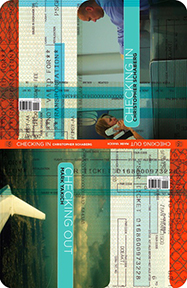My three-year-old wants to fly. Not in an airplane. She’s done that dozens of times, and that’s not at all what she means. She wants to hang in the sky like a butterfly, sail like a bird on wing, tremble in air like a bumblebee.
She jumps off the bed the way Peter and Wendy and Michael and John launch themselves to flight. When she leaps, she shouts, “HI-YA!” but tumbles to the floor.
“Why did I fall?” Her face furrows up.
“Gravity,” says her dad.
“They use ropes in the ballet,” I explain. “The dancers aren’t really flying.”
“But the real Peter Pan can fly. And Wendy. And fairies can fly.”
“Peter and Wendy aren’t real people,” we reply. “They’re part of a story. There isn’t a real Wendy or a real Peter Pan.”
“The ballet is real. I saw it,” she insists.
We try not to lie to her, but that boundary between imaginary and real is fuzzy. Isn’t that part of the magic and terror of childhood? Anything is possible.
“In the ballet they use ropes,” we remind her.
“In the ballet, they use ropes, but the real Wendy and the real Peter do fly,” she decides. So, it’s settled. No dissuading. Why would we try?
*
On the day before New Year’s Eve, we really do fly. On an airplane. To attend a wedding in DC.
Afterwards, we stay to see the sights, to spend time with family. At the Smithsonian National Air and Space Museum, my mother-in-law is the one most enraptured by angled jets and jumbo rockets perched above our heads.
“If I get another life, I’m coming back as an astronaut,” she confides, as we make our way to the child-themed exhibit: “Why Things Fly.”
Once inside, my daughter pulls at my hand until we land right at the Cessna 150 perched atop the room. Children line the steps and platform leading to the small plane’s cockpit.
When her turn arrives, my daughter climbs inside and sits to face the instrument panel. She lifts and lowers the flap on the back wing by moving the control column.
“Look! You’re really flapping the wing!” My mother-in-law croons so that my daughter turns her head to watch the wing move up and down. Finally, she turns back around and tries to gaze out the front windscreen.
As we walk back down the stairs, we ask if she had fun. “You flew a plane!” my mother-in-law hums in high-pitched tones.
“It wasn’t really flying,” my daughter tells us as we walk on through the exhibit.
“You’re right,” I agree. “But maybe when you’re older, you will learn to fly a plane. For real.”
“I already can, Mama! I already know how to fly!” she informs me. I don’t disagree.
*
Two days later, we board an early morning flight for Boise. The flight attendant smiles at my daughter as we step onto the plane.
“Well, hello, Princess! How are you? Do you want some wings?”
“Oh, we don’t really need another pair—” I begin, but my daughter reaches for them anyway, as if they are the first she’s ever received. As if these will be the ones to send her aloft in a breeze. She whispers thank you then peers back into the empty cockpit.
“If she’d like to come back up, the pilot will be here in about five minutes,” the flight attendant tells me as we shuffle toward the back. Visiting the pilot turns out to be impossible, though. The stream of passengers never ends until the attendants are striding through the cabin, commanding everyone to buckle up.
Since we don’t get to see the pilot before taking our seats, my daughter is curious. “Is the pilot a girl?” she asks.
“Maybe,” I answer. Slowly. My experience says, unlikely, and the International Society of Women Airline Pilots agrees. Only three percent of all commercial pilots are women. In my daughter’s short passenger experience, I don’t remember one airplane piloted by a woman.
“The pilot’s probably a man. A boy pilot,” my husband—speaking practically?—speaking for his gender?—tells her.
“You never know,” she turns to him. It’s her standard response to all things. Practical or otherwise.
“Well…actually, sometimes—” he stops himself, but he’s right. What are the odds?
“Well…actually, you NEV-ER know,” she insists.
My husband opens his mouth to contradict. I raise my eyebrows in his direction.
“Oh, that’s true,” he nods, turning parent mode back on full blast. “You NEV-ER know.” He repeats what’s become our family refrain.
At last, we are off, racing fast above the ground. We watch as the city morphs from life-sized to doll-sized in nearly an instant. Then clouds flood in to obscure that Lilliputian world.
We push our backs against the seats, and some of us begin to take deep breaths while the passengers in front of us tilt their chairs into our noses. My daughter asks if she can unbuckle her seatbelt. My daughter asks if we will read the safety card to her. My daughter asks for her coloring book. My daughter asks when the special treat of apple juice will arrive.
I’m not really paying attention when a voice finally comes over the PA: “Good morning, this is your pilot. We’ve reached our cruising altitude of 30,000 feet—”
I see my daughter pulling at my husband’s sleeve, and then both of them are turning to me.
“Did you hear?” My husband asks.
“The pilot!” yelps my girl.
“What? What?” I ask. “Is that the pilot speaking?”
“Yes!” My daughter’s smile is loud.
Then we are all smiling at each other. Forgetting about endless clouds outside the window. Forgetting about deep breaths. Forgetting seatbelts and safety cards and coloring books. Forgetting even apple juice.
We’re certain from her voice. The pilot is a woman.
Melanie J. Mendenhall lives and writes in Boise, Idaho. She enjoys mountain biking, traveling, and reading airplane stories, among others.






